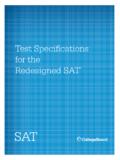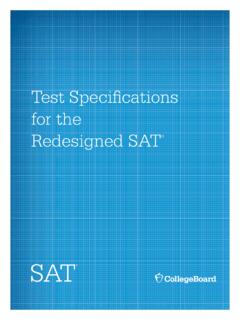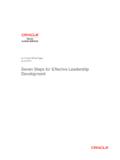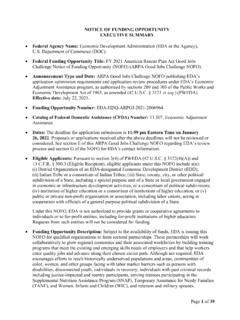Transcription of [STUDENT ACHIEVEMENT FACTORS] - ed
1 2012 South Dakota State University College of Education and Human Sciences Department of Teaching, Learning and Leadership Katherine Bertolini, Andrew Stremmel, Jill Thorngren [STUDENT ACHIEVEMENT FACTORS] Abstract: Effective practices for education are essential to insure public investment in our schools provides the maximum yield for our students, communities, states, and nation. The challenge has been defining and measuring terms such as effective, proficient, and sufficient when we examine instructional practice, student outcomes and funding equity. This position paper summarizes research findings on teaching practices, teacher training, parental involvement and other factors in relation to how each impacts student ACHIEVEMENT . Results of this literature review reveal complex and interrelated factors that impact student ACHIEVEMENT .
2 Recommendations for whole child instruction are made based on extensive literature that support the assets of a bio-ecological model of education. (Contains 1 diagram) Student ACHIEVEMENT Factors Student ACHIEVEMENT is impacted on numerous levels including students personal factors, their interactions with others such as parents, teachers, and administrators, and lastly the larger systems that surround the student school districts, neighborhoods, local economy, political policy, and multicultural relations. Bronfenbrenner s bio-ecological model illustrates a holistic view of the whole child in the full context of their world. The model contains four levels from the most personal to the externalized elements of a person s life experiences. Bronfenbrenner s Bio-ecological Model (1979) The factors within a student that have an impact on how they learn can be identified.
3 Creating policy (at every level of schools from building to federal levels) to improve learning outcomes is necessary to shape expectations. Extensive research is proving the efficacy of instruction for the whole child. This approach to education requires an awareness of the complexities of human learning and development. Learner centered instruction is designed to include four general areas: cognitive and metacognitive, motivational and affective, developmental and social, and individual differences (Cornelius-White & Harbaugh, 2010). Learner centered instruction extends the traditional knowledge transfer model to be more inclusive of the student s full life experiences. A paradigm shift from students deficits to students strengths and assets is a foundational requirement of learner centered instruction (Cornelius-White & Harbaugh, 2010).
4 When any factor is examined, practitioners must recognize the student s individual proficiency in any one of the factors can cover a wide range from profound deficits to mastery. The next section of this paper examines student ACHIEVEMENT factors that exist within each level of Bronfenbrenner s bio-ecological model. The factors that impact each level are explained and supported by elements that have been shown to positively impact child learning and development. Climate/culture(Macrosystem)Larger Community(Exosystem)Interactive Experiences (mesosystem) StudentPersonal (microsystem)Student ACHIEVEMENT Factors Researchers who have advanced the field in that particular area are noted for reference and future study. Micro System Factors The micro-system factors are comprised of traits within the student as well as their direct interactions with others such as teachers and other students.
5 Factors that have been found to have a significant impact on student learning and engagement in school are presented. Student Resiliency- the capacity to be self-righting despite adverse circumstances. When protective factors are present, the effects of adversity are mediated which encourages healthy development in 50 80 percent of a high risk population. These buffers appear to transcend history, ethnicity, and socioeconomic boundaries. (Benard, 2004) o Unconditionally supportive adult (Benard, 2004; Downey, 2008; Luthar, Cicchetti, & Becker, 2000; Werner & Smith, 1992) o Opportunities for mastery, self-efficacy and recognition (Bandura, 1977; Benard, 2004) Individual student abilities-cognitive and metacognitive factors affect the student s ability to learn, and more importantly to critically understand how to best understand and process information.
6 O Critical thinking opportunities (Marzano, Pickering, & Pollock, 2001) o Connection of learning to student context (past, present and future) o Selection of options for how learning can occur with some autonomy (Tomlinson, 2001) Health and attendance-motivational, physical, and affective factors o Real world learning with a purpose that always answers, Why do I have to do this? (Roberson, 2011) o Authentic inquiry and assessment (Cornelius-White & Harbaugh, 2010) o Health and nutrition promotion as a primary prevention (Durlak, 2000) Developmental differences- readiness for skills development o Redefining ACHIEVEMENT by assessing differently. Summative assessments to measure learning goals, models and criteria are shared in advance, assess before the instruction begins, offer choices for mastery, provide feedback, teach students to critically develop their own learning goals and measure their own progress, allow new evidence of learning to replace the old samples (Blankstein, 2010) o Diagnostic, formative and summative assessments (Blankstein, 2010) o Cooperative learning (Marzano et al.)
7 , 2001; Slavin, 1991) o Differential Instruction for students (Tomlinson & McTighe, 2006) o Students tutoring other students and contributing to the community (Benard, 2004) o Adjustment of school calendar to reduce summer learning losses Social and Moral Development is embedded in the culture of the family and community. Schools also develop a social and moral culture. o Social Justice Focus in Schools(Freire, 1968; hooks, 1994) o Integration of social and moral development into curriculum as well as vision, mission, Student ACHIEVEMENT Factors o Creation of intergrade, interschool safety nets for students (Blankstein, 2010) Meso-System Factors The interactions that surround each learner directly impact student ACHIEVEMENT . The following variables have been specifically identified as important in bolstering student success.
8 School climate as a welcoming and safe environment for learning o Multicultural competence (Cornelius-White & Harbaugh, 2010) o Supportive relationship building in all areas of child, parent, school system promotes values and norm development that positively influence student ACHIEVEMENT (Coleman, 1998) o Protected team time, advisory time (Blankstein, 2010; Littky, 2004) Parent Training and Partnering o Outreach programs to parents-authentic connections (Benard, 2004; Blankstein & Noguera, 2010; Dessoff, 2009) o Love & Logic parenting courses (Fay, 2012) o Shared expectation setting for vision/mission/values/goals with parents Professional Development for Teachers (von Frank, 2008) o Professional Learning Communities (Darling-Hammond & Rothman, 2011) o Personalized and teacher Driven (Darling-Hammond & Rothman, 2011) o Strengthened relationships for all stakeholders in the system (Blankstein, 2010) Building Leadership Capacity in teachers and administrators (Blankstein, Hargreaves, & Fink, 2010) o Redefined educational leadership, the distribution of who leads and systems for sustaining leadership (Darling-Hammond & Rothman, 2011; Hargreaves & Fink, 2010).
9 Teacher Evaluation o Mentor systems (Darling-Hammond & Rothman, 2011) o Support communities of shared responsibility and learning (Blankstein, 2010; Darling-Hammond, 2008; Darling-Hammond & Rothman, 2011) o Ongoing and asset based (Danielson, 2007; Darling-Hammond & Rothman, 2011) o Shared decision making for professional growth (Danielson, 2007) Peer Culture and ACHIEVEMENT (Expectations within the student body collective) o Focus groups that equally represent all student groups to meet with administration (Blankstein, 2010) o Collaborative, democratic expectations for the classroom (Cornelius-White & Harbaugh, 2010) o Clear communication of Schools Vision, Mission, Values, and Goals for all students (how is this made real in addition to banners and statements)(Blankstein, 2010) Exo- and Macro- Systems Factors Student ACHIEVEMENT Factors This layer is characterized by the societal factors and systemic factors that impact student learning.
10 While the factors exist on a large scale, interventions can be made on the meso-system to address the individual realities each student is experiencing. The interrelated risk factors listed below benefit from many of the same items that are listed in the micro and meso-systems. Logic dictates that students who experience the opposite end of the spectrum of the factors here have more beneficial learning opportunities and experiences. Socioeconomic disparities between families within schools as well as disparities between communities and states. Students in poverty neighborhoods do not perform as well as students from more affluent neighborhoods. o Advocacy and partnerships such as school and university alliances can meet needs within schools o Advocacy through national organizations such as the Children s Defense Fund, National Education Association and Association for Supervision and Curriculum Development create opportunities for policy influence.


















